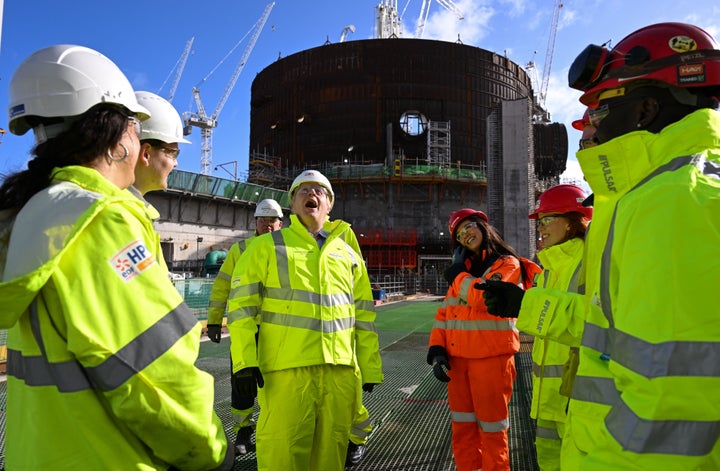
The government has finally published its energy security strategy.
Its aim is to make the UK less reliant on foreign imports - an issue which has been brought into sharp focus by Russia’s invasion of Ukraine - and, eventually, to reduce bills.
Weeks of behind-the-scenes wrangling between Number 10, the Treasury and the Department for Business, Energy and Industry Strategy, saw the document repeatedly delayed.
In his foreword, Boris Johnson says: “For years, governments have dodged the big decisions on energy, but not this one.
“We’ve got the ambition, we’ve got the vision – and, with this plan, we’re going to bring clean, affordable, secure power to the people for generations to come.”
So what is actually in the strategy? Here, HuffPost UK takes you through the main points of the government’s plan.
Nuclear
The government’s aim is for 25 per cent of the country’s power comes from nuclear.
To that end, ministers are setting up the Great British Nuclear Vehicle, whose job it will be to bring about a massive expansion in the number of power stations built in the country,
Up to eight more reactors could be build as part of the strategy, including smaller “modular” reactors, to replace Britain’s ageing fleet.
Offshore wind
The government’s ambition is to deliver up to 50 gigawatts of wind-generated power by 2030, by which time the document says “we will have more than enough wind capacity to power every home in Britain”.
This will include up to 5 gigawatts from floating sites, allowing access to the windiest spots and significantly increasing energy production.
In order to slash the time it takes to build new windfarms, the government aims to speed up the planning process.
“We will be the Saudi Arabia of wind power, with the ambition that by 2030 over half our renewable generation capacity will be wind, with the added benefit of high skilled jobs abounding these shores,” the strategy says.
Onshore wind
In the face of bitter opposition from Tory MPs - including senior ministers such as transport secretary Grant Shapps - the document significantly waters down the government’s plans to increase the amount of power generated by onshore wind.
An early draft of the strategy proposed trebling the amount generated to 45GW by 2035.
However, the document says that in England, there will be no “wholesale changes” to the current planning rules on onshore windfarms.
Instead, the government will “consult this year on developing local partnerships for a limited number of supportive communities who wish to host new onshore wind infrastructure in return for benefits, including lower energy bills”.
Solar
There is currently 14GW of solar capacity in the UK, and the document says it expects “a five-fold increase in deployment by 2035.
This will be done through a consultation on amending planning rules to strengthen policy in favour of development on non-protected land, while making sure communities still have a say, and moves to simplify planning permission for rooftop solar panels.
Oil and Gas
A new licensing round for North Sea projects is being launched in the aumtumn on the basis that producing gas in the UK has a lower carbon footprint than doing so abroad.
The document says: “The North Sea will still be a foundation of our energy security but we will have reduced our gas consumption by over 40 per cent by 2030.”
Fracking
Although the moratorium on fracking remains in place, the document opens the door to it re-starting by saying the government remains “open-minded about our onshore reserves”.
Ministers have commissioned a technical review on shale gas by the British Geological Society.
“Any exploration or development of shale gas would need to meet rigorous safety and environmental protection both above ground and sub-surface,” the document says.
Hydrogen
The strategy doubles the target for hydrogen production by 2030, to 10 gigawatts, with the intention of making at least half of that using electricity, which could come from clean renewables.
Hydrogen is seen as a potentially clean way of shifting from the use of fossil fuels, as it could be an alternative fuel for power plants, industrial processes, heavy goods vehicles and even instead of heating with gas boilers.